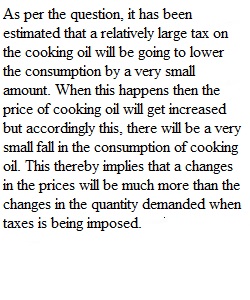


Q Question 1 4 / 4 pts Suppose that Norway wants to implement a tax on cooking oil that is high in saturated fat (unhealthy fats) in order reduce heart disease in the country. Answer the following written/mathematical questions in regards to the tax: 1) Economists in the Norwegian Government suspect that a relatively large tax on the cooking oil in question will reduce consumption by a very small amount. Are they assuming that the price elasticity of demand for the cooking oils is elastic or inelastic? (Clearly articulate your answer in at least two full sentences) 2) Do you think that the price elasticity of demand for the cooking oil differs between low-income and high-income consumers? Why? (Clearly articulate your answer using economic logic gained from the textbook in at least two full sentences). 3) Suppose that the Norwegian Government is considering “separate” taxes for two different types of cooking oils high in saturated fat: palm oil and coconut oil. After implementing small scale experiments with both taxes they estimate that the price elasticity of demand for palm oil is 0.5 and 0.4 for coconut oil. Assume that the Norwegian Government wants to reduce consumption by as much as possible and only has the resources to tax one of the oils. Which one will the Norwegian Government choose to tax? Why? (Clearly articulate your answer in a full paragraph) 4) Suppose that the Norwegian Government wants to reduce the quantity of coconut oil consumption by 23% in order to reach their health improvement goals. How much does the tax need to be in order to meet their goals assuming a price elasticity of demand of 0.5? 5) Suppose the Norwegian Government implements a 50% tax on coconut oil. How much will coconut oil consumption drop by if we assume a 0.5 price elasticity of demand? Will the Norwegian Government reach its goal of reducing coconut oil consumption by 20%? How much is the excise tax per packet of salt? Who actually remits the tax and how do we know which entity actually remits or physically pays the tax (Clearly articulate your answer in a sentence or two.) 2) Suppose that the U.S. Federal Government assumes that the exact same number of packets of table salt will be sold after the tax than as before the tax was implemented. How much revenue is the U.S. Federal Government projected to collect? 3) What is the actual excise tax revenue? Why is the actual excise tax revenue less than the projected tax revenue? What was the U.S. Federal Government assuming about consumers? (Clearly articulate your answer in a few sentences for full points.) 4) What is the fraction of the tax borne by demanders? What is the fraction of the tax borne by suppliers? (Provide and submit the the elasticity calculations into the textbox below as an image. Ignore the endpoint problem. Please make sure that your image is NOT an HEIC or HEIF file. You should upload your image as a JPEG file or a PNG file.) 5) How realistic are the tax burden calculations in part 4, given the market we are in and the good we are analyzing? (Fully articulate your answers in at least a paragraph using economic concepts and logic.) 6) What is the deadweight loss from the implementation of the tax? (Fully articulate and explain why deadweight loss occurs from the implementation of a tax in at least a couple sentences) 1) Budget Constraint=$10. Suppose you have purchased 1 ice cream and 1 hot dog. Are you maximizing utility? If so, explain why. If not, what combinations of goods should you buy? (Show your calculations, recreate and fill in the table, and submit your work as an image into the textbox below. Please make sure that your image is NOT an HEIC or HEIF file. You should upload your image as a JPEG file or a PNG file.)
View Related Questions